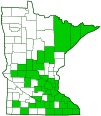Ohio spiderwort
(Tradescantia ohiensis)
Conservation • Wetland • Description • Habitat • Ecology • Use • Distribution • Taxonomy
Description |
||
Ohio spiderwort is a 16″ to 40″ tall, erect, perennial forb that rises on 1 to many stems from thick, fleshy, fibrous roots. The stems are erect or ascending, often branched, usually hairless, bluish-green, and covered with a whitish, waxy or powdery film (glaucous). There are 3 to 8 nodes on the stem and up to 9″ between nodes. The leaves are alternate, linear, 4″ to 14″ long, and ¼″ to ¾″ wide but usually less than ⅜″ wide. They are flat, not rolled or keeled, firm, usually hairless, grayish-green or bluish-green, and glaucous. They form an angle of less than 90° with the stem and curve into an arch like a bow. The upper leaves are as narrow or narrower than the part of the leaf that surrounds the stem when it is opened and flattened. The base of the leaf surrounds the stem. The tip tapers to a point with concave sides along the tip. The margins are untoothed. The inflorescence is a tight, umbrella-like cluster of many flowers arising from the same point. They appear at the end of the stem, at the ends of branches, and often on long stalks rising from the leaf axils. A pair of bracts below the inflorescence are 1″ to 8″ long, similar to and about the same size as the leaves, but distinctly keeled. The flowers are 1″ to 1½″ wide. They are on ¼″ to 1⅛″ long, hairless stalks which droop when in bud, becoming erect when the flower opens. The sepals are glaucous and usually hairless, but may have a tuft of hairs at the tip. The 3 petals are broadly egg-shaped and deep blue to purple or rarely white. There are 6 stamens with bright yellow anthers. The petals last only one day, opening in the morning then turning to jelly in the mid-day heat. The central flowers bloom first. There is no floral scent. The fruit is a papery, round capsule ¼″ or less in diameter with 3 to 6 seeds. |
||
Height |
||
16″ to 40″ |
||
Flower Color |
||
Deep blue to purple |
||
Similar Species |
||
Bracted spiderwort (Tradescantia bracteata) is a smaller plant, 16″ to 24″ tall at maturity. The stems are usually unbranched and bright green. The leaves are bright green and keeled, not flat. Neither the stems nor the leaves are glaucous. The bracts are 2″ to 12″ long, often longer and wider than the leaves. The sepals and flower stalks are densely hairy with both long and short hairs. Prairie spiderwort (Tradescantia occidentalis var. occidentalis) is a smaller plant, 8″ to 24″ tall at maturity. The leaves are bright green and rolled inward toward the upper side, not flat. The sepals and flower stalks are sparsely hairy with minute, glandular hairs. However, hairiness of sepals and flower stalks is an unreliable indicator in the field, as they may not be obvious and may be overlooked. |
||
Habitat |
||
Dry, moderate, or moist. Prairies, meadows, thickets, roadsides. Full to partial sun. |
||
Ecology |
||
Flowering |
||
April to July |
||
Pests and Diseases |
||
|
||
Use |
||
|
||
Distribution |
||||
|
Sources |
|||
| 3/1/2023 | ||||
Nativity |
||||
Native |
||||
Occurrence |
||||
Common |
||||
Taxonomy |
|||
| Kingdom | Plantae (Plants) | ||
| Division | Tracheophyta (Vascular Plants) | ||
| Subdivision | Spermatophytina (Seed Plants) | ||
| Class | Liliopsida (Monocots) | ||
| Subclass | Commelinidae | ||
Order |
Commelinales (spiderworts and allies) | ||
Family |
Commelinaceae (spiderworts) | ||
| Subfamily | Commelinoideae | ||
| Tribe | Tradescantieae | ||
| Subtribe | Tradescantiinae | ||
Genus |
Tradescantia (spiderworts) | ||
Subgenus |
Tradescantia | ||
Subordinate Taxa |
|||
|
|||
Synonyms |
|||
Tradescantia canaliculata Tradescantia foliosa Tradescantia incarnata Tradescantia ohiensis var. foliosa Tradescantia reflexa |
|||
Common Names |
|||
bluejacket common spiderwort Ohio spiderwort smooth spiderwort |
|||
Glossary
Axil
The upper angle where the leaf stalk meets the stem.
Bract
Modified leaf at the base of a flower stalk, flower cluster, or inflorescence.
Glaucous
Pale green or bluish gray due to a whitish, powdery or waxy film, as on a plum or a grape.
Keeled
Folded, as in a grass blade, or with a raised ridge, as in a grass sheath; like the keel of a boat.
Linear
Long, straight, and narrow, with more or less parallel sides, like a blade of grass.
Node
The small swelling of the stem from which one or more leaves, branches, or buds originate.
Sepal
An outer floral leaf, usually green but sometimes colored, at the base of a flower.
Sheath
The lower part of the leaf that surrounds the stem.
Visitor Photos |
|||||
Share your photo of this plant. |
|||||
| This button not working for you? Simply email us at info@MinnesotaSeasons.com. Attach one or more photos and, if you like, a caption. |
|||||
|
|||||
MinnesotaSeasons.com Photos |
|||||
Habitat |
|||||
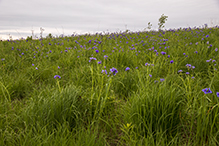 |
|||||
Plants |
|||||
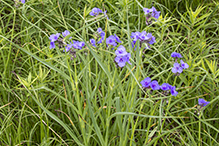 |
|||||
Inflorescence |
|||||
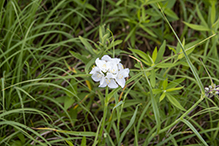 |
|||||
Flowers |
|||||
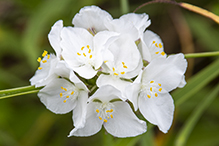 |
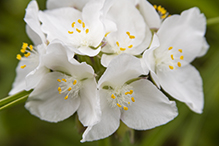 |
||||
Sepals |
|||||
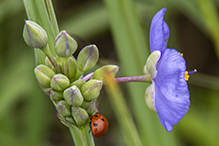 |
|||||

Slideshows |
||
| Tradescantia ohioensis (Common Spiderwort) Allen Chartier |
||

|
||
| Tradescantia ohiensis COMMON SPIDERWORT Frank Mayfield |
||
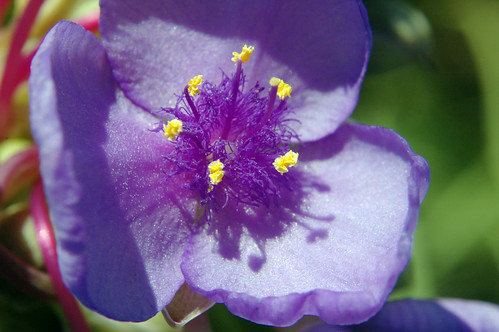
|
||
| Ohio Spiderwort - Tradescantia ohioensis NativeWildflowers |
||
About
Published on Jan 18, 2013 Earthyman shows Ohio Spiderwort - Tradescantia ohioensis blooming at Ion Exchange native seed and plant nursery. Spiderwort blooms in June and may bloom again in the fall. Slender, erect stems, often with a purple tinge. Flowers are blue to purple, occasionally white and appear in dense clusters at the tops of the stems. Leaves are long and quite like those of an Iris. Found in dry to mesic praires and savannas and along roadsides and railroads. Relatively common to all but the northwest portions of the Tallgrass biome. Seeds and plants and be purchased at http://nativewildflowersandseeds.com |
||

Visitor Videos |
|||
Share your video of this plant. |
|||
| This button not working for you? Simply email us at info@MinnesotaSeasons.com. Attach a video, a YouTube link, or a cloud storage link. |
|||
Other Videos |
|||
| Ohio Spiderwort is a Good Native Pollinator Ionxchange |
|||
About
Published on Jun 27, 2013 Earthyman views Ohio Spiderwort (Tradescantia ohiensis) at Ion Exchange, Inc native seed and plant nursery in Northeast Iowa. Let's give the bees a little help by planting more native prairie plants. http://www.ionxchange.com |
|||
| Tradescantia ohiensis Opening.wmv FLPhotoCatcher |
|||
About
Published on Apr 9, 2012 Timelapse of the flower Tradescantia ohiensis opening in Florida. (common name Ohio Spiderwort). The flowers open before sunrise. The bug caused the flowers to move a little. |
|||
| Tradescantia ohiensis Spider Wort dullard69 |
|||
About
Published on Jun 18, 2013 A nice little flowering plant |
|||
| Bumblebee visits spiderwort in Columbus, Ohio, USA Robert Klips |
|||
About
Uploaded on Dec 28, 2010 A bumblebee briefly visits a flower of Ohio spiderwort (Tradescantia ohioensis) at a garden in Columbus, Ohio, USA on May 29, 2010. |
|||

Visitor Sightings |
|||||
Report a sighting of this plant. |
|||||
| This button not working for you? Simply email us at info@MinnesotaSeasons.com. Be sure to include a location. |
|||||
|
|||||
MinnesotaSeasons.com Sightings |
|||||

Created 6/25/2005
Last Updated:
